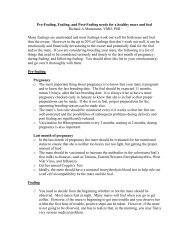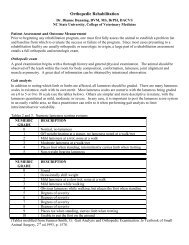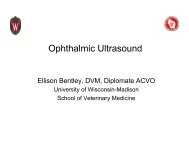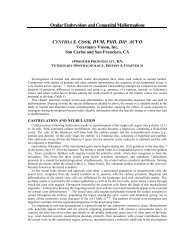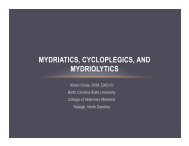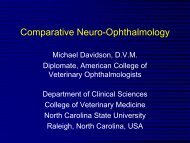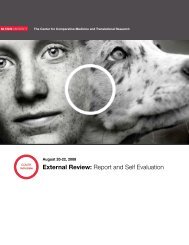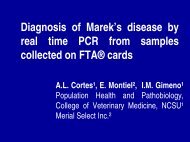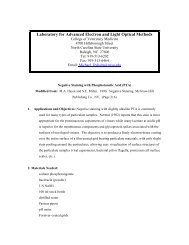Retinoscopy - North Carolina State University College of Veterinary ...
Retinoscopy - North Carolina State University College of Veterinary ...
Retinoscopy - North Carolina State University College of Veterinary ...
- No tags were found...
You also want an ePaper? Increase the reach of your titles
YUMPU automatically turns print PDFs into web optimized ePapers that Google loves.
Lens Systems <strong>of</strong> theMammalian Eye• cornea:• 70-80% <strong>of</strong> refractive power• 40-4545 diopters in dog• crystalline lens:• 20-30% <strong>of</strong> refractive power• 13-15 diopters in dog• in emmetropic eye, brinngs incident id light raysfrom optical infinity to point source on retina
Basic Definitions <strong>of</strong> Refraction and RefractivePropertiesEmmetropia - an eye without refractive error wherethe pluslens <strong>of</strong> the the cornea and crystalline lenses refract light to apint source on the retinaAmmetropia - an eye with a refractive error, generally fromvariations in the axial length <strong>of</strong> the eye, astigmatismss, or ashift in position or absence <strong>of</strong> the lensHyperopia - an eye with a refractive error caused byrelatively too little refractive power, generally caused by ashorter than normal axial lengthMyopia - an eye with a refractive error caused by relativelytoo great a refractive power, generally caused by a longerthan normal axial lengthAstigmatism - an aspherical ammetropia, caused when therefractive surfaces <strong>of</strong> the eye have different radii <strong>of</strong> curvaturein different meridians, generally caused by differencee incorneal curvatures. Such an eye has two principle foocalpoints, or two points <strong>of</strong> focus on incident light rays.Anisimetropia - difference in refractive state <strong>of</strong> the two eyes
Principles <strong>of</strong> <strong>Retinoscopy</strong> or“Putting Yourselfat the Far Point<strong>of</strong> thhe Patient’s Eye”
<strong>Retinoscopy</strong> (Skiascopy)• objective means <strong>of</strong> determiningrefractive or dioptric state <strong>of</strong> theeye• observing characteristic lightrays or “reflexes” created byilluminating i the retina with aband <strong>of</strong> light from a retinoscope• the character <strong>of</strong> these reflexes,and how they are influenced byrefractive lenses placedbetween the eye andretinoscope, indicates refractivepower <strong>of</strong> the eye
Design <strong>of</strong> Retinoscoope• light projection system:• tungsten bulb filament emits astreak <strong>of</strong> light• condensing lens which changesvergence <strong>of</strong> light• sleeve which controls vergence bychanging orientation <strong>of</strong> mirror, andcontrols (horizontal or vertical)direction <strong>of</strong> light streak• examiner observation system:• peephole aperture allows examinerto view emergent light rays from theeye
Design <strong>of</strong> Retinoscoope• light projection system:• tungsten bulb filament emits astreak <strong>of</strong> light• condensing lens which changesvergence <strong>of</strong> light• sleeve which controls vergenceby changing orientation <strong>of</strong> mirror,and controls (horizontal orvertical) direction <strong>of</strong> light streak• examiner observation system:• peephole aperture allowsexaminer to view emergent lightrays from the eye
Design <strong>of</strong> Retinoscoope• light projection system:• tungsten bulb filament emits astreak <strong>of</strong> light• condensing lens which changesvergence <strong>of</strong> light• sleeve which controls vergenceby changing orientation <strong>of</strong> mirror,and controls (horizontal orvertical) direction <strong>of</strong> light streak• examiner observation system:• peephole aperture allowsexaminer to view emergent lightrays from the eye
Design <strong>of</strong> Retinoscope• light projection system:• tungsten bulb filament emitsa streak <strong>of</strong> light• condensing lens whichhchanges vergence <strong>of</strong> light• sleeve which controlsvergence by changingorientation <strong>of</strong> mirror, andcontrols (horizontal orvertical) direction <strong>of</strong> lightstreak• examiner observationsystem:• peephole aperture allowsexaminer to view emergentlight rays from the eye
Design <strong>of</strong> Retinosscope• light projection system:• tungsten bulb filament emits astreak <strong>of</strong> light• condensing lens which changesvergence <strong>of</strong> light• sleeve which controls vergenceby changing orientation <strong>of</strong>mirror, and controls (horizontalor vertical) direction <strong>of</strong> lightstreak• examiner observationsystem:• peephole aperture allowsexaminer to view emergent lightrays from the eye
Refracting Lens• trial lens set:• plus and minus spherical lensesin 0.25D increments• plus cylinder lenses forspherocylindrical refractiontechnique• lens (skiascopy) bar or rack:• series <strong>of</strong> spherical plus andminus lenses in increments <strong>of</strong>0.5D to 1.0D• in U.S., black bar contains pluslenses, red bar minus lenses,European designs may be theopposite
Incident Light Raysand Refractive e <strong>State</strong>• incident light rays acted onby lens systems <strong>of</strong> the eye• emmetropic eye:• focal point on retina• hyperopic eye:• focussed beyond retina• myopic eye:• focussed in front <strong>of</strong> retina (invitreous)
RetinoscopicReflexes• emergent light rays reflectingfrom an illuminated retinaleave the eye and are refractedby the lens systems <strong>of</strong> the eyein the same manner asincident light rays• emmetropia:• leave eye as parallel rays• hyperopia:• leave eye as diverging rays• myopia:• leave eye as converging rays
Far Point <strong>of</strong>the Eye• point in space, conjugatewith, or corresponding to,the retina• emmetropic eye:• far point AT infinity• hyperopic eye:• far point BEYOND infinity• myopic eye:• far point IN FRONT OFinfinity• with emergent light rays,the further the far point isfrom infinity, the greater therefractive error
Emergent Light Raysfrom a Retinoscope• appear as band <strong>of</strong> light, withadjacent shadow as streak ispassed across patient’s pupil• diverging i or parallel l lightrays:• “with” motion (moves in samedirection as sweep)• light rays have come to afocal point and crossed:• “against” motion (moves inopposite direction to sweep)• light rays at the far point (inthe process <strong>of</strong> crossing):• pupil fills with light, no motionseen…“neutralization”
Emergent Light Raysfrom a Retinoscope• appear as band <strong>of</strong> light, withadjacent shadow as streak ispassed across patient’s pupil• diverging or parallel light rays:• “with” motion (moves in same directionas sweep)• light rays have come to a focalpoint and crossed:• “against” motion (moves in oppositedirection to sweep)• light rays at the far point (in theprocess <strong>of</strong> crossing):• pupil fills with light, no motionseen…“neutralization”
Emergent Light Raysfrom a Retinoscope• appear as band <strong>of</strong> light, withadjacent shadow as streak ispassed across patient’s pupil• diverging or parallel light rays:• “with” motion (moves in samedirection as sweep)• light rays have come to a focalpoint and crossed:• “against” motion (moves inopposite direction to sweep)• light rays at the far point (in theprocess <strong>of</strong> crossing):• pupil p fills with light, no motionseen…“neutralization”
Emergent Light Raysfrom a Retinoscope• appear as band <strong>of</strong> light, withadjacent shadow as streak ispassed across patient’s pupil• diverging or parallel light rays:• “with” motion (moves in samedirection as sweep)• light rays have come to a focalpoint and crossed:• “against” motion (moves inopposite direction to sweep)• light rays at the far point (in theprocess <strong>of</strong> crossing):• pupil p fills with light, no motionseen…“neutralization”
Emergent Light Raysfrom a Retinscope• if far point is beyond theretinoscope, a withmotion is seen• if far point is betweenthe eye and theretinoscope, an againstmotion is seen• If at far point,neutralization ti is seen• examiner’s goal is t<strong>of</strong>ind far point
Emergent Light Raysfrom a Retinscope• if far point is beyond theretinoscope, a withmotion is seen• if far point is betweenthe eye and theretinoscope, an againstmotion is seen• If at far point,neutralization ti is seen• examiner’s goal is t<strong>of</strong>ind far point
Emergent Light Raysfrom a Retinscope• if far point is beyond theretinoscope, a withmotion is seen• if far point is betweenthe eye and theretinoscope, an againstmotion is seen• If at far point,neutralization ti is seen• examiner’s goal is t<strong>of</strong>ind far point
Retinoscopic ReflexesViewed at Infinityemergent light raysfrom emmetropic andhyperopic eyes havenot yet converged to afocal point:• “with” motionemergent light raysfrom myopic eye haveconverged, crossed,and begun to diverge:• “against” motion
<strong>Retinoscopy</strong> Workking Distance• optical infinity it (>6meters)too distant from eye toperform retinoscopy• infinity recreated by placingretinoscope at a knowndistance from eye, the“working distance” andplacing a “working lens” inthe path <strong>of</strong> reflected lightrays
<strong>Retinoscopy</strong> at 1 Meter• emmetropia and hyperopia:• “with” motion• myopia >1diopter:• against motion• add 1 D “working lens” infront <strong>of</strong> eye:• emmetropic eye at far point =“neutralization”• to reach far point for otherrefractive states:• add more plus lens to 1 D forhyperopic p eye• add more minus lenses to 1D for myopic eye
<strong>Retinoscopy</strong> at 1 Meter• emmetropia and hyperopia:• “with” motion• myopia >1diopter:• against motion• add 1 D “working lens” infront <strong>of</strong> eye:• emmetropic eye at far point =“neutralization”• to reach far point for otherrefractive states:• add more plus lens to 1 D forhyperopic p eye• add more minus lenses to 1D for myopic eye
<strong>Retinoscopy</strong> at 1 Metter• emmetropia and hyperopia:• “with” motion• myopia >1 diopter:• against motion• add 1 D “working lens” infront <strong>of</strong> eye:• emmetropic eye at far point =“neutralization”• to reach far point for otherrefractive states:• add more plus lens to 1 D forhyperopic p eye• add more minus lenses to 1D for myopic eye
Finding the Far Point• “with” motion wantsPLUS lenses• “against” motionwants MINUS lenses
<strong>Retinoscopy</strong> at 66 cm• with no working lens:• emmetropia, hyperopia, &myopia 1.5 D shows“against” motion• use 1.5 D “working” lens:• emmetropia showsneutralization• hyperopia shows “with”motion (add plus lenses)• myopia shows “against”motion (add minus lenses)
<strong>Retinoscopy</strong> at 66 cm• with no working lens:• emmetropia, hyperopia, &myopia 1.5 D shows “against”motion• use 1.5 D “working” lens:• emmetropia showsneutralization• hyperopia shows “with” motion(add plus lenses)• myopia shows “against” motion(add minus lenses)
<strong>Retinoscopy</strong> Workinng Distance• a single lens is used forboth the “working lens” andadditional “correcting”lenses• when neutralization isreached, subtract theworking lens strength fromgross (total) refraction toyield net refraction• 66cm = working lens <strong>of</strong>+1.5D• 50cm = working lens <strong>of</strong>+2.0D
Technique <strong>of</strong> <strong>Retinoscopy</strong>semidarkened room, assistant holdsanimal, directs gazeretinoscope held in palm, thumb on sleeve,lens bar in other hand, distance 66 or 50cm from patientvergence set by moving sleeve down,direction set so vertical streak projected oneyeoptical alignment…align Purkinje imagesstreaks brought into pupil with slow,deliberate movement (shake head backand forth), neutralizesleeve rotated to produce horizontal streak
Identifying i Neutralitty• with no lenses, determine ifmotion, or neutrality:“with” motion, “against”• note that all emmetropes andalmost all ammetropes willshow a “with” motion at 66 cmwith no refractive lenses• with motion = add progressiively stronger plus lenses• against motion = add minuslenses• because against motion difficult to see:• to confirm, reverse vergence, “against” becomes a “with”!!• approach neutrality from “with” side….go past neutrality untilwith motion seen, bracket bacck to neutrality
Characteristics <strong>of</strong> Neutrality• great distances fromneutrality:• reflexes are dull, slow moving,streak is fairly broad• within 4 diopters <strong>of</strong> neutrality:• streak becomes narrow, distinct• within 2 diopters neutrality:• streak becomes faster andbrighter• at neutrality:• streak is infinitely fast (no motionis seen), very bright, and lightfills pupil
Characteristics <strong>of</strong> Neutrality• great distances fromneutrality:• reflexes are dull, slow moving,streak is fairly broad• within 4 diopters <strong>of</strong> neutrality:• streak becomes narrow, distinct• within 2 diopters neutrality:• streak becomes faster andbrighter• at neutrality:• streak is infinitely fast (nomotion is seen), very bright, andlight fills pupil
Confirming Neutraality• neutrality not a point, but rathera zone between the lastrecognizable “with” motion andthe first recognizable “against”motion• judge endpoint slightly on the“with” motion side <strong>of</strong> this zone(point when last recognizable,slight “with” motion is seen)• at neutralization, ti lean forwardfrom 66 cm to observe withmotion, lean backward from 66cm to observe “against”motion…..(“reversal point”)
EstimatingHyperopia• “enhancement”estimates grosshyperopia• compare thickness <strong>of</strong>beam in pupil (retinalband) vs. outside thepupil (face band)• slowly raise vergenceuntil the beam <strong>of</strong> light isthe thinnest possible
Estimating Hyperopia•
Estimating Myopia• “far point determination”estimates net myopia• if against motion observed at 66cm, >1.5 D myopia present• change vergence by movingsleeve up to confirm• move sleeve back down, slowlymove progressively slower toeye, streaking beam untilneutralization reached• estimate your distance from theeye at neutrality
Astigmatism• Astigmatism - an asphericalammetropia, caused when therefractive surfaces <strong>of</strong> the eye havedifferent radii <strong>of</strong> curvature indifferent meridians, generallycaused by difference in cornealcurvatures. Such an eye has twoprinciple focal points, or two points<strong>of</strong> focus on incident light rays.
Astigmatic RefractiveErrorsneutralization seen with differentlenses in two different meridiansor…when neutralization reachedin one meridian, streak is rotated,either a “with” or “against” motionis seenmajor or principle meridians:• least and most refractivemeridiansda • generally oriented with axesat or near 90 degrees and180 degrees
Astigmatic RefractiveErrors• neutralization seen with differentlenses in two different meridians• or…when neutralization reachedin one meridian, streak is rotated,either a “with” or “against” motionis seen• major or principle meridians:• least and most refractivemeridiansda • generally oriented with axesat or near 90 degrees and180 degrees
Astigmatic Refractive Errors• simple astigmatism• compound astigmatism• mixed astigmatism• oblique astigmatism• regular astigmatism• irregular astigmatismat s• “break” phenomena
Astigmatic Refractive Errors• simple astigmatism• compound astigmatism• mixed astigmatism• oblique astigmatism• regular astigmatism• irregular astigmatismat s• “break” phenomena
Designating Refracctive Error• determine net refraction inboth vertical and horizontalmeridians• if refraction is same, eye is“spherical”, if two meridiansare different eye is“astigmatic”• average the two meridiansto get “average” refractivestate• or…designate twomeridians with “lens cross”
Designating Refracctive Error• determine net refraction inboth vertical and horizontalmeridians• if refraction is same, eye is“spherical”, if two meridiansare different eye is“astigmatic”• average the two meridiansto get “average” refractivestate• or…designate twomeridians with “lens cross”+1.5D+0.5D
Practical Aspects <strong>of</strong><strong>Veterinary</strong> Retinosccopy• use retinoscopy bar vs. trial lenssetset• good assistant invaluable• estimating techniques useful and reduce refraction time• optical alignment critical• mydriasis reduces accuracy in identifying neutrality:• full mydriasis causing swirling or “scissors” motion• if mydriasis present, concentrate on center <strong>of</strong> pupil• brightness <strong>of</strong> tapetum is useful in identifying neutrality• refracting aphakes or pseudophakes:• opaque ocular media• surgically-induced astigmatism• on pseudophakes, reflex different in pupil covered by IOL optic and that areaoutside <strong>of</strong> IOL optic



